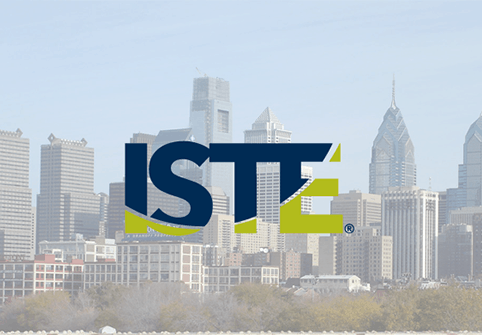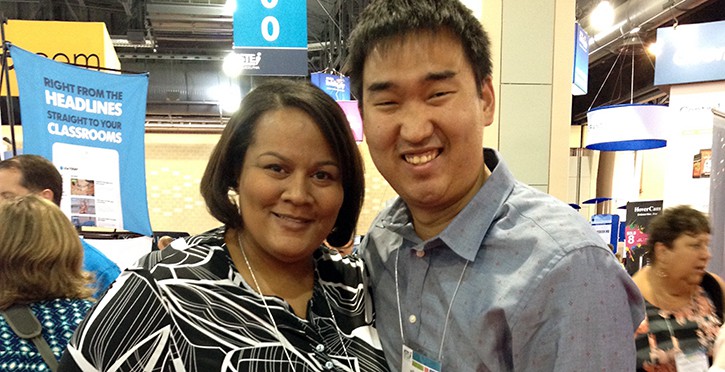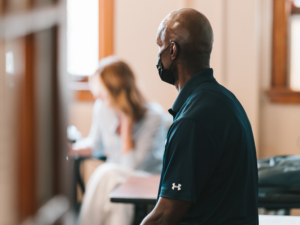Making Sure People Don’t Get Lost in the EdTech Shuffle

Albert Kim
The message at this year’s ISTE conference was loud and clear: Technology can and will change education, but not without people. This might seem obvious, but at the world’s biggest EdTech conference, it’s easy to lose sight of the people as you wade through hundreds of new products, tools, and practices.
So how do schools and nonprofits make sure that people don’t get lost in the EdTech shuffle?
Understanding What’s Possible
During the opening keynote, educator and ISTE rock star Rafranz Davis spoke about the role and responsibility of educators to change the paradigm of what is possible for students. “You cannot be what you cannot see,” Davis said. She shared examples of how women in tech are inspiring young girls to pursue careers in STEM. She reminded us that seeing someone who looks like you succeeding in a field that you previously thought was closed can have a lasting impact on a young person. She encouraged us to not lose sight of the people — caring teachers, role models, mentors — who often make the difference when it comes to our students’ success.

“As we embrace the reality that we are all part of the village that raises the child, what will it take to raise us?”
Davis’ query resonates, not only for students, but also for educators. As many hustle to stay on top of the latest trends, hopping between the 900-plus sessions at a conference like ISTE, it’s no surprise that we walk away with more information than we know what to do with and have no single idea of where to start.
Veteran ISTE goers like Davis, Jennie Magiera, and others, have championed the value of connecting with other educators as the path to innovation and growth. Seeing and hearing directly from leaders in the space only confirms that idea.
Davis, Magiera, David Flores Jr., George Couros, and Chris Lehmann discussed using technology to turn a classroom into an immersive learning environment, as well as redefining what quality professional development can look like and making inquiry a cornerstone of a school’s culture. Their thinking inspires and propels others to pursue the same.
Redefining Professional Development
Too many educators agree that professional development is often done to them—not for or by them. Many are moving to a place where educator interests, time, and feedback are at the center of PD. In Ohio, Bobby Dodd, a high school principal, following the practice of flipping classrooms, is flipping his staff meetings. Instead of using traditional staff meetings — sending out agendas 24 hours before and delivering lecture-style content — he is prioritizing inter-teacher and staff collaboration, diving deeper into fewer topics, and modeling the innovative mindset that he expects to show up in his teachers’ classrooms. Dodd is creating a meeting structure that promotes the type of collaboration, creativity, and culture that he and the rest of his team desire to see in their building.
While training and PD opportunities are good practice, promoting them in lieu of having an organizing framework or clear long-term goals can be shortsighted and often fails to bring about the desired change. On a panel discussing how to align professional development with the changing expectations of a digitally delivered curriculum, Ashley Hays from Eduscape Learning emphasized the importance of a long-term approach that prioritizes development of the blended learning skill set and not an educator’s ability to use a single tool.
Others at ISTE have focused on presenting different approaches to building blended instruction competencies by focusing on the relationship between traditional and new learning frameworks. By aligning Bloom’s Taxonomy with SAMR, educators are providing their peers with an accessible way to plan for and think through the choices they make within their blended learning environments, from using Google docs to foster collaboration in the classroom to partnering with a classroom overseas to create a digital portfolio about being a global citizen.
As a representative of an organization that believes in the power of relationships and leveraging the power of technology to build them, it has been refreshing to see both at the center of education’s future.
For more, check out:
- EdTech 10: ISTE… The Superbowl of EdTech
- Robots Storm ISTE: 6 Implications
- Relationships Matter: Online Learning & Virtual Cohorts

Albert Kim is the Managing Director of Program Design at iMentor. Follow Albert on Twitter, @AlbertKKim.




0 Comments
Leave a Comment
Your email address will not be published. All fields are required.